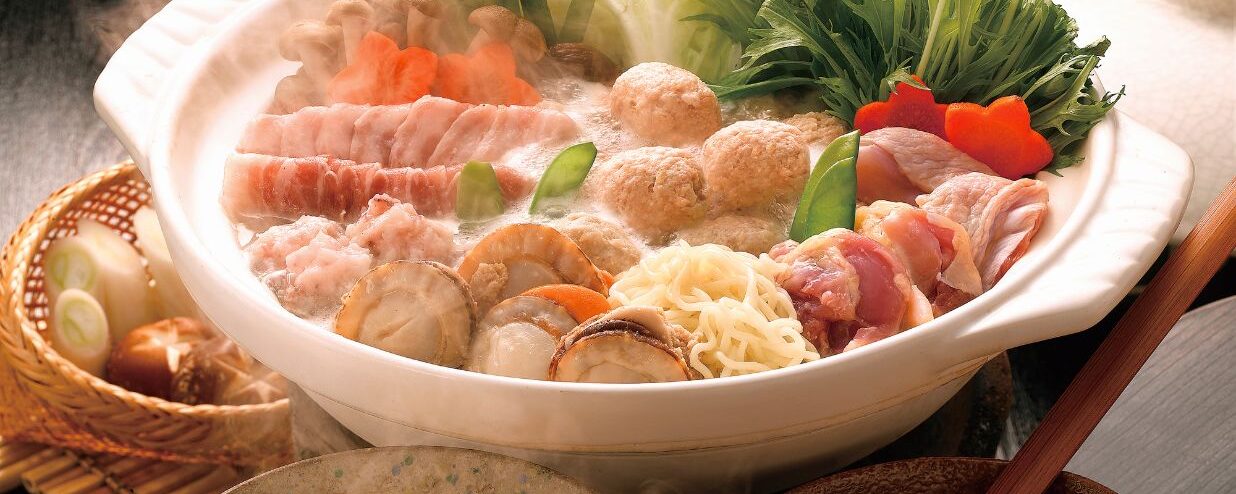With temperatures dropping and the chilly winter months quickly approaching us, what better way to stay nice and toasty than to savor some comforting food? If you’re in Japan, there is no shortage of mouth-watering options to choose from when selecting a tasty meal to warm your stomach during the winter months. In our list of must-try foods in Japan, we will be giving you a guide to everything that you need to try this season, from year-round goods to food that is special to the Japanese wintertime.
When is Winter in Japan?
Winter in Japan generally lasts from December to February, but the exact conditions depend on the region. Northern areas like Hokkaido are cold with heavy snow, central regions such as Tokyo are chilly with occasional frost, and southern areas like Kyushu and Okinawa are milder with little to no snow.
What Else to Do Besides Eating During Winter in Japan?
Winter in Japan is famous for its cozy food culture, from hot bowls of nabe and sukiyaki to steaming odens. But winter isn’t just about eating. It’s also the perfect season to immerse yourself in Japanese culture and language. Here’s what else you can do besides eating while in Japan during the colder months!
1. Learn Japanese in Real-Life Situations
If you’re traveling to Japan or looking for ways to make your holiday a little more productive, why not use the opportunity to learn Japanese while you’re there? Schools like Coto Academy offer flexible, beginner-friendly lessons that you can take for as little as a week — perfect for fitting into a vacation schedule.
Coto Academy’s approach is tailored for travelers and short-term students, with interactive lessons that focus on practical communication, cultural insights, and real-world scenarios. In just a few days, you can start understanding signs, asking questions, and having simple conversations!
2. Explore Winter Festivals
Japan comes alive in winter with snow festivals like the Sapporo Snow Festival or regional illuminations. These events are perfect for cultural immersion and practicing Japanese, whether it’s reading festival signs or asking locals about exhibits. Check out our guide on the best Christmas market in Japan and where to see winter illuminations in Tokyo.
3. Hot Springs (Onsen) Adventures
Winter is the perfect season to visit an onsen (hot spring). Many onsen towns, like Hakone or Kusatsu, are especially scenic when covered in snow, creating a magical and relaxing atmosphere. We recommend not just staying in Tokyo, but taking day trips to nearby towns or even venturing further north to places like Hokkaido, which is famous for its snowy landscapes and hot springs.
In addition to ryokan (traditional inns) with private onsens, you can also find public onsens, which are a more casual and affordable way to experience this iconic Japanese tradition. Check out our recommendations for the best onsen destinations in Japan.

1. Yakiimo (Roasted Japanese Sweet Potato)
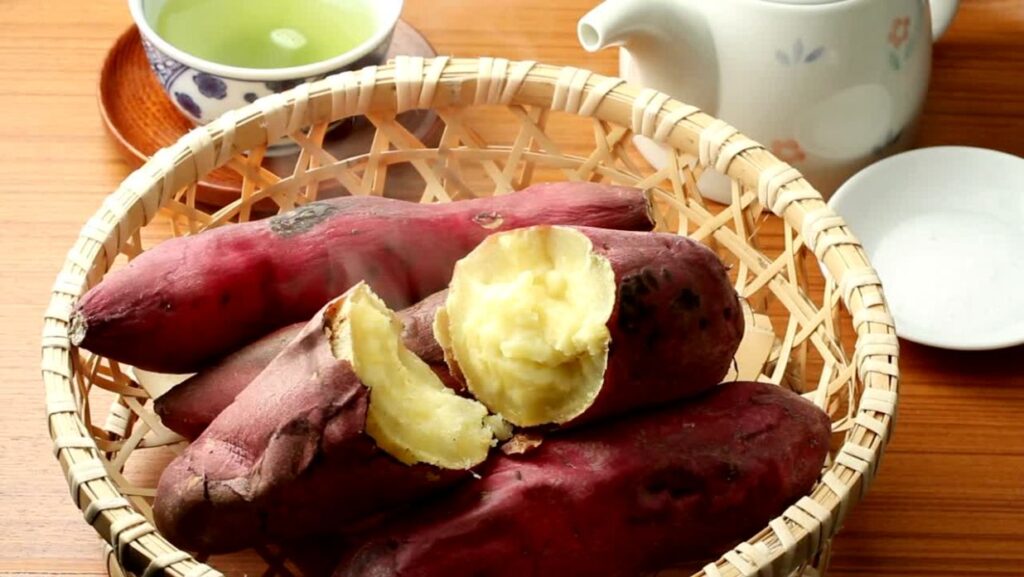
Kicking off our list is yakiimo. The baked and roasted sweet potato is technically a Japanese autumn food, but it is often eaten during the colder months in Japan. Yakiimo has a smooth and creamy texture, with a rich sweetness that makes it taste more like a dessert than a vegetable. Yakiimo is a great snack in the winter since it is served hot, making it an ideal treat to warm you up on a minus-zero degree Celsius day. Yakiimo is also widely accessible during this time of year, with this sweet snack being sold in supermarkets, convenience stores, and by street vendors all across Japan during the winter.
2. Tonjiru (Pork miso soup)
Tonjiru is a comforting Japanese soup made using miso as a base, pork as the meat, and vegetables like daikon radish, carrots, and burdock root. Tonjiru is a very hearty and filling dish, offering both sustenance and a warm feeling of comfort when eaten. Tonjiru is a popular soup during the winter months since it is a high-fat dish and is rich in minerals from the many vegetables included in the soup, making it a hearty option that can be easily adjusted to each person’s palate and preferences.
3. Ramen

This is a dish that needs no introduction. One of Japan’s most famous and cozy dishes, ramen is a Japanese staple that may be surprisingly overlooked during the winter months due to its year-round popularity. Ramen consists of five key components: noodles, broth, tare (seasoning), toppings, and oil. Ramen can be highly personalized to preferences based on spiciness and sweetness levels, meat preferences, scent aromas, sauces, and a wide range of common toppings.
The four bases for ramen are shoyu (soy sauce), tonkotsu (pork bone), shio (salt), and miso (fermented soybean paste). Shoyu is a lighter broth with a salty soy flavor, shio is a light broth that is seasoned with salt, miso is a combination of savory and sweet, and tonkotsu is a rich and creamy broth. Typical ramen toppings include a protein (typically pork or chicken), boiled eggs, green onions, bamboo shoots, mushrooms, seaweed, and bean sprouts.
Want to learn how to order ramen like a pro? Take a look at our article on how to order ramen in Japan.
4. Nikujaga

Looking for a hearty meal this winter season? Then you need to try nikujaga. This Japanese dish consists of beef or pork as a meat, potatoes, onions, carrots, and an assortment of additional vegetables based on individual preferences. The ingredients are prepared in a savory broth made of soy sauce, dashi, sugar, and mirin. This dish balances savory and sweet flavors with its comforting flavor profile, with many Japanese families having their own recipes for the dish.
The dish can also vary depending on the region, with many in eastern Japan preferring to use beef as the meat base, while in western Japan, using pork is more common. Nikujaga is also a great option due to its nutritional benefits, with healthy ingredients such as vegetables being mixed in with the protein of choice and providing essential nutrients, and supporting a well-balanced diet.
5. Nikuman (Steamed meat buns)

Nikuman is a savory steamed pork bun that is originally based on the Chinese baozi buns before being adopted by the Japanese. In addition to the pork, nikuman filling can consist of shiitake mushrooms, cabbage, and onions. These buns are often seasoned with sesame oil and soy sauce as well, adding an umami flavor to this hearty snack.
Nikuman is a great snack to enjoy during the winter months in Japan for several reasons. One, the buns are always served fresh and hot, and can be easily purchased from restaurants, supermarkets, and even convenience stores. Second, nikuman’s meat and vegetable fillings make it a filling snack that is also rich in flavor, making it a tasty snack that is enjoyed by many all across Japan during the colder months.
Want to know even more popular Japanese snacks? Check out our article covering Japanese treats throughout the year.
6. Nabe (Japanese Hotpot)

Having a get-together with friends or loved ones this winter? Nabe is best enjoyed when in a communal setting, as this Japanese winter food unites groups of friends with its delectable flavors and wide range of personalization for individual preferences. Nabe translates to “hot pot”, referencing the simmering pot of broth placed at a table where the ingredients are cooked together. There are many options that you can use in your hot pot, with a vast assortment of vegetables and meats being the typical choices. Common vegetables include cabbage, mushrooms, shimeji, spinach, enoki, leeks, Daikon radish, green onions, potatoes, and bean sprouts.
For meats, typical choices include variations of beef, chicken, and pork belly. Nabe can also be enjoyed using seafood such as salmon, shrimp, and crab. Many Japanese people partake in hot pot with friends, family, and co-workers as the lively atmospheres of Nabe restaurants and the communal cooking arrangement create an exciting environment that encourages conversation and bonding.
Having the freshly-cooked ingredients still sizzling on your plate and the warm steam from the pot brushing against your face will keep you nice and toasty this winter as you savor a traditional Japanese dining experience. Additionally, many hot pot restaurants are open late into the night, making nabe a great choice for all hours of the day.
Want to try some Japanese recipes for yourself? Check out our article for the essentials of Japanese cooking.
7. Mikan

Mikan is a type of mandarin orange that serves a wide range of uses in Japanese cooking. While it may seem odd that a fruit is considered a classic winter food item, as fruits are more often associated with spring and summer in other areas of the world, mikans are synonymous with winter here in Japan. These oranges can be enjoyed in their natural form as a snack and provide many nutrients and vitamins that are beneficial for good health.
Mikans contain vitamin C, which assists in antioxidant and immune system support, beta-carotene, which supports eye health, and beta-cryptoxanthin that prevents cell damage, just to name a few. This is one of the reasons Mikans have become a winter staple, as many believe their health benefits can help deter sickness and common colds prevalent during this time of year. Mikans also peak in sweetness between the months of September to February, making winter the optimal time to enjoy them.
In addition to their unaltered forms, mikans can also be eaten in a wide range of settings. Mikan is commonly used as a topping for tarts and cakes, mikan juices, candied and dried mikan, and mandarin mochi. This sweet, tangy, and nutritious snack is a great option for your winter in Japan.
8. Oden

Oden is a hearty stew that is commonly eaten in Japan during the winter. As with many winter foods in Japan, the specific ingredients can vary based on personal preferences, but typical oden is made with kelp broth and dried bonito flakes. Fish is a main staple in oden, with various types of fish cakes such as chikuwa (tube-shaped fish cake) and hanpen (soft, white fish cake) being commonly used. Other typical ingredients in oden include Daikon radish, boiled eggs, konyaku (gelatinous cake made from konjac yam), potatoes, beef tendons, and fried tofu.
This winter food in Japan is considered a healthy dish by many since it is low in fat and rich in proteins and nutrients, making it a comforting and nutritious meal for the colder months. If you are seeking an even more health-conscious option, you can choose the Kansai-style oden over Kanto-style, with Kansai using a kelp-based dashi broth that is lighter than Kanto’s stronger soy-sauce base.
9. Shabu-Shabu
Shabu-shabu is another winter food in Japan in on our list that is best enjoyed in the company of others. While shabu-shabu has some similarities with nabe, which we covered earlier in the list, the key difference is that shabu-shabu specifically refers to thinly-sliced meat being simmered in a rich broth before being dipped into a sauce. Nabe involves cooking many ingredients in the same pot, while shabu-shabu focuses on cooking meat.
Common meats used in shabu-shabu include beef, pork, lamb, and chicken. There are also seafood and vegetarian options, with crab and lobster being used for fish and tofu being used for vegetarians. The hot meats served alongside savory sauces make shabu-shabu a lovely choice for the winter, as the simmering heat will quickly warm up your body from the chilly weather.
10. Miso Soup
Miso soup is another famous Japanese soup that you have likely heard of or tried before. Miso soup is well-known for its umami flavor, having a savory and salty flavor profile that can be adjusted to be milder or more intense depending on personal preferences. Miso soup is made of dashi (a savory broth) and miso paste (from fermented soybeans) as primary ingredients. There are many different types of miso, including white miso (mild, sweet), red miso (strong, salty, earthy), Hatcho miso (deep, rich, bitter), and mixed miso (heartier than white, less intense than red).
There are also quite a lot of toppings you can add to your miso soup, such as tofu, wakame seaweed, green onions, shiitake mushrooms, and cabbage, to name a few. Miso soup is also rich in probiotics, antioxidants, essential vitamins and minerals, which can make it a healthy choice for the winter, especially if a lighter miso is used to reduce sodium intake.
11. Crab
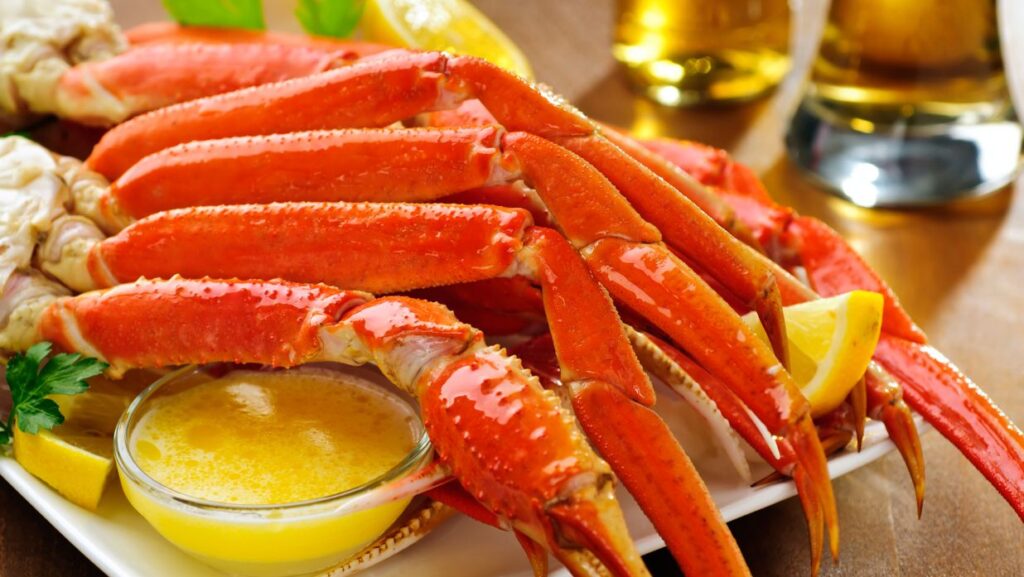
The sight of massive crabs on beds of ice in restaurants and fish markets instantly signals the start of the winter season in Japan. From November through March, Japan brings an abundance of snow crabs, red king crabs, and horsehair crabs.
Winter is prime crab season because the low temperatures make crabs more active, which subsequently firms their meat and allows them to reach their peak size after molting. Crab harvesting in Japan is concentrated along the Sea of Japan coast, particularly in the Hokuriku region (Fukui, Ishikawa, and Toyama prefectures) and the San’in region (Tottori and Shimane prefectures). Hokkaido is also a major harvesting area, benefiting from its cold waters.
Crabs, especially ones served whole and in restaurants, are considered luxurious, though you can find more affordable options like crab cream croquettes.
12. Fugu
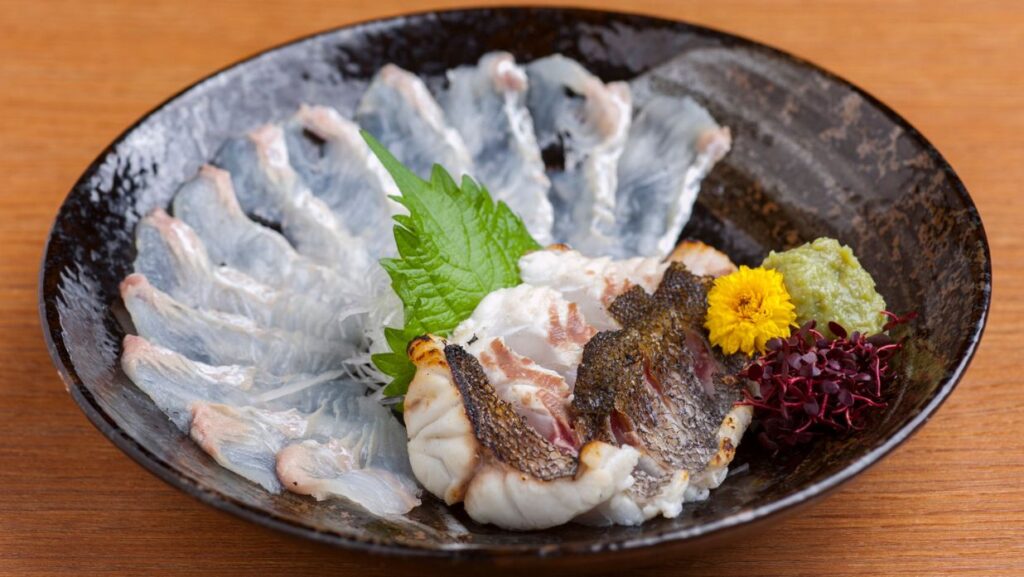
This perilous blowfish packs enough poison to kill a person — odorless, tasteless tetrodotoxin — but when prepared by licensed fugu chefs, it becomes a delicacy. November to February is when fugu is most prized, as the fish fatten to survive the cold, with its prized shirako (milt) reaching peak quality between January and March. Farmed fugu, meanwhile, is available year-round.
Fugu is remarkably versatile in the kitchen. It can be served raw as sashimi or cooked by grilling, simmering, or frying. Most parts of the fish are edible, with the exception of certain organs — liver, ovaries, eyes, and skin — which contain the highest concentration of its toxin.
13. Yuzu
A member of the same citrus family as mikan, this winter fruit in Japan is a sour, fragrant Japanese citrus fruit. Its flavor is subtly bitter and less sour than a lemon, with floral notes and a unique aroma found in no other citrus.
In the colder months, hot yuzu drinks at convenience stores provide a comforting warm-up, while yuzu kosho — a spicy citrus pepper paste — adds bright, zesty heat to soups like nabe and ramen.
Interestingly, yuzu is not just eaten, but used for wellness. On the winter solstice, many Japanese take a traditional yuzu bath. This age-old practice is believed to ward off colds, flu, and soothe chapped skin.
14. Yakimochi
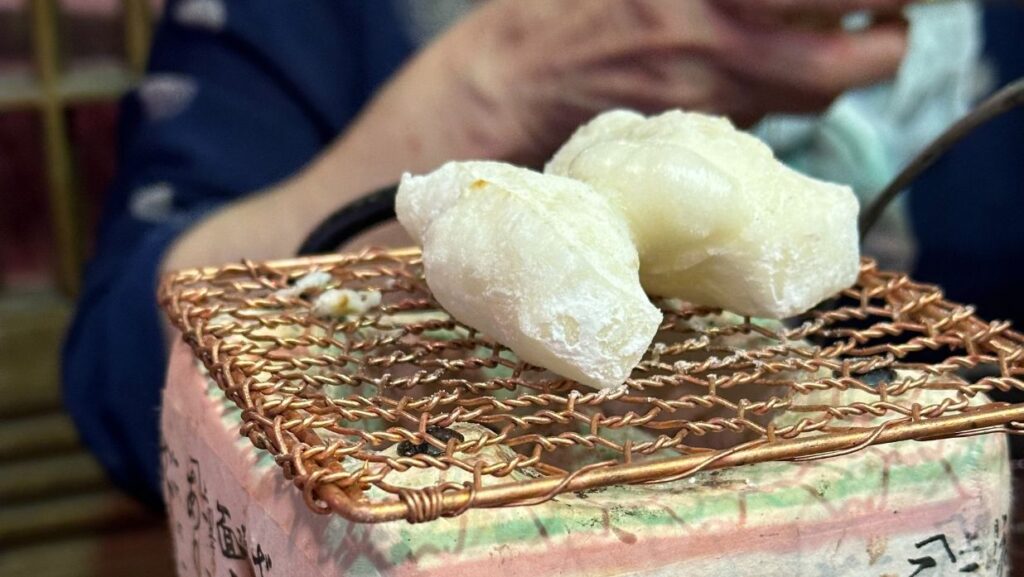
Technically, yakimochi (grilled mochi) is not an exclusive winter food in Japan, but while it can be eaten year-round, it holds special significance during the New Year season. This popular food is believed to bring good luck and prosperity. During New Year festivities, families across Japan often add sticky mochi balls to hot ozoni soup — clear dashi- or miso-based broth.
15. Root Vegetables
Thankfully, winter foods in Japan are not just about meat and potatoes. Winter in Japan is the season for hearty root vegetables. You can find daikon (Japanese white radish), burdock root (gobo), turnips, and lotus root in peak season.
Stay Warm This Winter With All the Great Food!
There are many delicious Japanese foods to choose from that will keep you nice and warm this winter. If you want to improve your Japanese language skills alongside tasting all of the incredible food Japan has to offer, contact us here at Coto Academy and master your Japanese in no time!
Learn Beyond Japanese Autumn Foods and Speak Japanese with Lessons at Coto Academy!
Now that you’ve learned the basics of Japanese winter food, why stop there? There are plenty of other essential skills to master, like introducing yourself or discussing a specific topic in conversation.
If you want to build confidence and start speaking Japanese, consider joining conversation-focused Japanese lessons at Coto Academy. As a top-rated school with campuses in Tokyo and Yokohama, we offer fun and flexible lessons designed around practical, everyday conversation. You’ll learn Japanese that you can use immediately outside the classroom.
We offer intensive Japanese courses as well as part-time options, so whether you want to immerse yourself fully or fit lessons into a busy schedule, there’s something for you. Start your journey to speaking Japanese confidently today!
Why join Coto Academy?
- Over 60+ different Japanese classes over 18 levels
- Small classroom of only up to 8 students for personalized support
- Professional, native Japanese teachers
Ready to get started? Fill out the form below to contact us!
FAQ
What is a popular winter food in Japan?
There are many foods that are eaten in Japan during the winter months. Ramen, tonjiru, shabu-shabu, and nikujaga are some of the most commonly eaten foods during the winter.
What do picky eaters in Japan eat?
Picky eaters in Japan typically enjoy the fried chicken (karaage), yakitori (grilled skewers), ramen, and curry rice. These are all foods that appeal to a wide range of palettes without having flavors that are too acquired or strong in intensity.
What Japanese food is good in cold weather?
There is a wide variety of Japanese foods that are suitable for the cold weather. Cook-it-yourself meals like nabe and shabu-shabu are good in the winter since the food is still sizzling when you eat it from the broth, and the warm steam will quickly heat you up. Foods such as yakiimo and nikuman are great winter snacks, as they are both served hot and serve as a fast, easy, and tasty treat during the winter.
What are the 3 most popular foods in Japan?
Out of all the well-known Japanese foods, it is difficult to choose only 3 that are among the most popular. In general, sushi, ramen, and tempura are the most popular foods in Japan. These three Japanese culinary staples are enjoyed by tourists and locals alike, and for good reason. They are all delicious and provide widely different flavors, with sushi being an umami classic, ramen being cozy and filling, and tempura being crispy and light.
